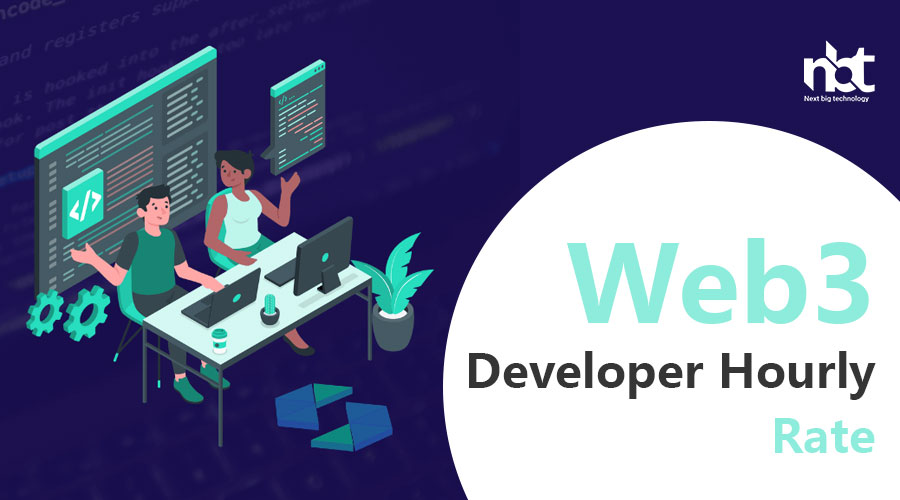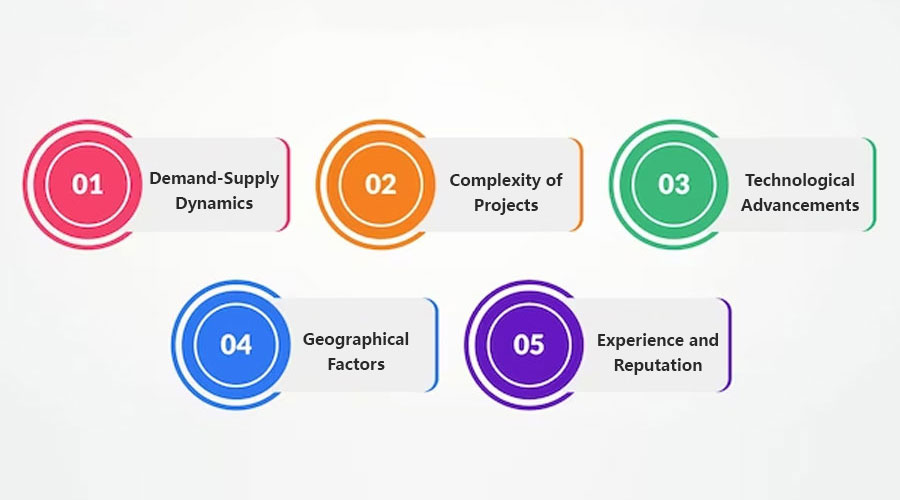Table of Contents
Understanding Web3 Development Rates
In recent years, the world of technology has witnessed a significant shift towards decentralization, with the emergence of Web3 technology at the forefront. As more businesses and individuals explore the potential of blockchain, decentralized applications (dApps), and smart contracts, the demand for Web3 development services has surged. However, understanding the intricacies of Web3 development rates can be a daunting task for many.
So, what exactly are Web3 development rates, and how can one navigate through this evolving landscape? Let’s delve deeper into this topic.
What is Web3 Development?
Before delving into the rates, it’s crucial to grasp the fundamentals of Web3 development. Web3 refers to the next generation of the internet, characterized by decentralized, peer-to-peer networks facilitated by blockchain technology. Unlike Web 2.0, which relies heavily on centralized servers and intermediaries, Web3 aims to empower users by granting them greater control over their data and digital assets.
Web3 development encompasses a wide range of activities, including building decentralized applications (dApps), smart contracts, decentralized finance (DeFi) protocols, non-fungible tokens (NFTs), and more. Developers proficient in blockchain technologies such as Ethereum, Polkadot, Solana, and others play a pivotal role in driving innovation within the Web3 ecosystem.
Factors Influencing Web3 Development Rates
Several factors influence Web3 development rates, making it essential to consider various variables when estimating project costs. Some of the key factors include:
- Complexity of the Project: The complexity of a Web3 project significantly impacts development rates. Projects requiring advanced smart contract functionality, complex consensus mechanisms, or intricate decentralized architectures often incur higher costs.
- Technology Stack: The choice of blockchain platform, programming languages, and development frameworks can affect pricing. Platforms like Ethereum and Solidity are widely used but may command higher rates due to their popularity and ecosystem maturity.
- Experience and Expertise: Experienced developers with a proven track record in Web3 development may charge premium rates for their services. The depth of expertise in blockchain technologies and related domains can influence the overall cost of development.
- Scope and Timeline: The scope of work and project timeline play a crucial role in determining development rates. Projects with tight deadlines or evolving requirements may require additional resources, thereby impacting costs.
- Market Demand: Market dynamics and demand-supply forces also influence Web3 development rates. High demand for skilled developers in emerging technologies like blockchain can drive up prices, especially in competitive markets.
Understanding Web3 Development Pricing Models
Web3 development rates are typically structured based on various pricing models, including:
- Hourly Rates: Many developers charge an hourly rate for their services, wherein clients pay for the actual time spent on development tasks. Hourly rates can vary widely depending on factors such as the developer’s experience, location, and the complexity of the project.
- Fixed-price Contracts: In fixed-price contracts, developers agree to complete the project for a predetermined sum. This model works well for well-defined projects with clear deliverables and timelines, providing clients with cost certainty.
- Retainer Agreements: Retainer agreements involve ongoing support and maintenance services for Web3 projects. Clients pay a recurring fee to retain access to developer expertise and support, ensuring continuous improvement and updates.
Tips for Navigating Web3 Development Rates
Navigating Web3 development rates requires careful consideration of various factors and informed decision-making. Here are some tips to help you effectively manage costs and maximize value:
- Define Clear Objectives: Clearly define your project objectives, scope, and deliverables to ensure alignment with your budget and timeline.
- Evaluate Developer Expertise: Assess developers’ expertise, portfolios, and track records in Web3 development to gauge their suitability for your project.
- Request Detailed Quotes: Obtain detailed quotes from multiple developers or agencies, ensuring transparency regarding pricing, deliverables, and timelines.
- Consider Long-term Implications: Look beyond upfront costs and consider the long-term implications of your Web3 project, including maintenance, scalability, and future updates.
- Negotiate Terms: Don’t hesitate to negotiate terms and pricing to reach a mutually beneficial agreement with developers or agencies.
Market Demand and Supply Dynamics in Web3 Development
In the ever-evolving landscape of technology, the emergence of Web3 has sparked a revolution, redefining how we interact, transact, and envision the digital realm. With its decentralized architecture, enhanced security, and promise of greater user control, Web3 development has captured the imagination of developers, entrepreneurs, and enthusiasts alike. However, understanding the intricate interplay of market demand and supply dynamics in this burgeoning sector is essential for navigating its complexities and seizing opportunities for growth and innovation.
Market Demand: Unraveling the Craving for Web3 Solutions
The market demand for Web3 development stems from a confluence of factors, driven by the shortcomings of its predecessors and the aspirations for a more inclusive, secure, and transparent digital ecosystem.
- Decentralization: Traditional web platforms have long been plagued by issues of centralization, leading to data breaches, censorship, and privacy concerns. Web3 promises to address these shortcomings by distributing data across a decentralized network of nodes, thereby enhancing security and resilience.
- User Empowerment: With Web3, users gain greater control over their data and digital identities, fostering a sense of empowerment and ownership. This shift aligns with evolving consumer preferences, where individuals seek more agency and autonomy over their online interactions.
- Interoperability and Integration: Web3 facilitates seamless interoperability between disparate systems and platforms, enabling the creation of interconnected ecosystems and fostering innovation. This interoperability is crucial for driving adoption across diverse industries and use cases, ranging from finance and gaming to healthcare and supply chain management.
- Tokenization and Incentive Mechanisms: The integration of blockchain technology in Web3 enables the tokenization of assets and the implementation of incentive mechanisms, such as smart contracts and decentralized autonomous organizations (DAOs). These features incentivize participation, drive engagement, and unlock new monetization models, fueling the demand for Web3 solutions.
Supply Dynamics: Navigating the Landscape of Web3 Development
While the demand for Web3 solutions continues to soar, navigating the supply dynamics presents its own set of challenges and opportunities for developers, entrepreneurs, and investors.
- Technological Expertise: Developing Web3 solutions requires a deep understanding of blockchain technology, cryptographic protocols, and decentralized systems. As such, there is a growing demand for skilled developers proficient in languages such as Solidity, Rust, and JavaScript, as well as frameworks like Ethereum, Polkadot, and Solana.
- Infrastructure and Tools: Building robust Web3 applications necessitates access to reliable infrastructure and development tools. This includes blockchain platforms, development frameworks, testing suites, and deployment services. The availability and quality of these resources influence the speed, scalability, and security of Web3 solutions.
- Regulatory Environment: The regulatory landscape surrounding Web3 development is still evolving, with varying degrees of clarity and oversight across jurisdictions. Navigating these regulatory challenges requires a nuanced understanding of compliance requirements, legal frameworks, and risk mitigation strategies.
- Community and Collaboration: Web3 development thrives on community-driven collaboration, with open-source ethos and knowledge sharing playing a pivotal role. Engaging with developer communities, participating in hackathons, and contributing to decentralized projects are essential for building networks, gaining insights, and fostering innovation.
Geographic Variances in Web3 Developer Rates
In the digital age, the world of technology is ever-evolving, and with the emergence of Web3, the landscape of development is undergoing a paradigm shift. Web3, characterized by decentralization, blockchain technology, and smart contracts, has spurred a demand for skilled developers to build decentralized applications (dApps) and blockchain-based solutions. However, one fascinating aspect that often goes unnoticed is the geographic variances in Web3 developer rates.
Across the globe, different regions exhibit distinct characteristics in terms of technological infrastructure, education systems, and economic conditions, all of which influence the rates at which Web3 developers are hired. Let’s delve into some key geographic variances in Web3 developer rates:
1. Silicon Valley and Tech Hubs: Unsurprisingly, tech hubs like Silicon Valley in the United States boast some of the highest rates for Web3 developers. The region’s vibrant tech ecosystem, access to venture capital, and high cost of living contribute to premium rates for Web3 talent. Developers here can command top dollar for their expertise in blockchain development, smart contracts, and decentralized finance (DeFi) applications.
2. European Centers: Europe, home to burgeoning tech scenes in cities like London, Berlin, and Zurich, also offers competitive rates for Web3 developers. With a strong emphasis on innovation and a robust startup culture, European countries attract skilled developers with competitive salaries and benefits. Moreover, the European Union’s regulatory framework regarding cryptocurrencies and blockchain technology adds to the demand for proficient Web3 developers.
3. Emerging Markets: In contrast, emerging markets in Asia, Africa, and Latin America present a different scenario. While the demand for Web3 developers is growing rapidly in these regions, the rates tend to be comparatively lower. Factors such as lower cost of living, abundance of tech talent, and government incentives for technology adoption contribute to this trend. Countries like India, Nigeria, and Brazil are witnessing a surge in Web3 development activities, albeit at relatively lower rates compared to their counterparts in developed economies.
4. Remote Work: The rise of remote work has further blurred geographic boundaries in Web3 development rates. With the advent of decentralized work environments and the prevalence of remote-friendly collaboration tools, developers can now work for companies across different regions without being bound by geographical constraints. This has led to a more fluid market where rates may vary based on factors such as project complexity, developer experience, and client budget rather than just geographic location.
5. Talent Migration: Another noteworthy trend is the migration of Web3 talent towards regions offering better opportunities and higher compensation. Developers from emerging markets may seek employment in tech hubs with higher rates, contributing to a brain drain effect in their home countries. Conversely, tech companies in developed economies may tap into talent pools from emerging markets to mitigate costs while maintaining quality standards.
Experience Levels and Hourly Rate Correlation
In the dynamic landscape of freelancing and job markets, experience often plays a significant role in determining hourly rates. Whether you’re a freelancer setting your prices or a business seeking to hire, understanding the correlation between experience levels and hourly rates is essential for making informed decisions. Let’s delve into this relationship and explore how it impacts both freelancers and clients.
Experience is the bedrock of expertise. It encompasses the skills, knowledge, and insights gained over time through practical exposure and learning. In the realm of freelancing, experience levels are typically categorized into three main tiers: entry-level, mid-level, and senior-level.
Entry-level freelancers are those who are relatively new to the field. They may have basic skills and limited experience, often acquired through internships, academic projects, or entry-level positions. Due to their novice status, entry-level freelancers usually offer their services at lower hourly rates compared to their more experienced counterparts. This serves as an incentive for clients to take a chance on them and allows entry-level freelancers to build their portfolios and gain valuable experience.
Mid-level freelancers have acquired a moderate level of experience and expertise in their respective fields. They have honed their skills through practical work experience, continuous learning, and possibly specialized training or certifications. Mid-level freelancers typically command higher hourly rates than entry-level freelancers, reflecting their increased proficiency and value to clients.
Senior-level freelancers are the seasoned veterans of their industries. They possess extensive experience, advanced skills, and a proven track record of delivering high-quality results. Senior-level freelancers often specialize in niche areas and offer specialized services that demand a premium. Consequently, they charge the highest hourly rates among freelancers, commensurate with their expertise and the value they bring to projects.
Now, let’s explore the correlation between experience levels and hourly rates from the perspective of both freelancers and clients.
For freelancers, setting hourly rates requires careful consideration of their experience level, skills, market demand, and cost of living. Entry-level freelancers may initially set lower rates to attract clients and build their reputations. As they gain experience and confidence in their abilities, they can gradually increase their rates to reflect their growing expertise and demand. Mid-level freelancers strike a balance between competitive pricing and fair compensation for their skills and experience. Senior-level freelancers have the flexibility to command premium rates based on their established reputation and track record of success.
On the other hand, clients must assess the value proposition offered by freelancers relative to their hourly rates. While entry-level freelancers may offer cost-effective solutions, clients should weigh the potential risks and benefits of entrusting critical projects to less experienced professionals. Mid-level freelancers offer a balance between affordability and competence, making them suitable for a wide range of projects. Senior-level freelancers justify their higher rates with their extensive experience, specialized skills, and the assurance of top-notch results, making them ideal for complex or high-stakes assignments where quality is paramount.
Project Complexity and Its Influence on Hourly Rates
In the realm of freelancing and consulting, determining hourly rates can be a challenging task. Numerous factors come into play, and one significant aspect is the complexity of the project at hand. Understanding how project complexity influences hourly rates is crucial for both freelancers and clients alike. Let’s delve deeper into this intricate relationship.
What is Project Complexity? Project complexity refers to the level of intricacy involved in completing a task or a series of tasks within a project. It encompasses various elements such as the scope of work, technical requirements, degree of uncertainty, and the skill set required to execute the project successfully. Complex projects typically demand more time, effort, and expertise to accomplish compared to simpler ones.
How Does Project Complexity Impact Hourly Rates?
- Time Commitment: Complex projects often require a significant investment of time due to their intricate nature. Freelancers and consultants need to dedicate more hours to understand the project requirements, conduct research, develop strategies, and implement solutions. Consequently, they may charge higher hourly rates to compensate for the extended time commitment.
- Specialized Skills: Dealing with complex projects often necessitates specialized skills and expertise. Freelancers with advanced technical knowledge or niche capabilities are in high demand for tackling intricate tasks. As a result, they can command premium hourly rates commensurate with their proficiency and experience in handling complex projects.
- Risk and Uncertainty: Complex projects inherently entail greater risk and uncertainty. There may be unforeseen challenges, technical hurdles, or scope changes along the way, leading to potential delays or revisions. Freelancers may factor in these risks when determining their hourly rates to mitigate any adverse impacts on their profitability.
- Value Proposition: Clients understand that complex projects require a higher level of expertise and effort to deliver satisfactory results. They are willing to pay premium rates for freelancers who can effectively navigate through complexities and deliver superior outcomes. Hence, freelancers who consistently demonstrate their ability to add value to complex projects can justify charging higher hourly rates.
- Market Demand: The demand-supply dynamics also play a significant role in determining hourly rates for complex projects. If there is a scarcity of skilled professionals capable of handling intricate tasks within a specific niche or industry, freelancers may have the leverage to set higher rates to capitalize on the demand.
Emerging Web3 Development Niches and Their Rate Implications
In the ever-evolving landscape of technology, Web3 development stands out as a beacon of innovation, offering decentralized solutions and redefining how we interact with the digital world. As this field continues to expand, new niches within Web3 development are emerging, each with its unique set of challenges and opportunities. In this article, we delve into some of these burgeoning niches and discuss their implications on development rates.
- Decentralized Finance (DeFi): DeFi has been one of the most prominent and rapidly growing sectors within Web3 development. It encompasses a wide range of financial services built on blockchain technology, including lending, borrowing, trading, and asset management. Developers in this niche are tasked with creating secure, efficient, and user-friendly platforms that enable seamless interaction with decentralized financial products. Given the complexity and critical nature of DeFi protocols, development rates for skilled professionals in this field tend to be higher compared to other niches.
- Non-Fungible Tokens (NFTs): NFTs have taken the digital world by storm, revolutionizing concepts of ownership and authenticity. From digital art to virtual real estate, NFTs have found applications across various industries. Web3 developers specializing in NFTs are responsible for creating smart contracts, marketplaces, and platforms that facilitate the creation, trading, and management of these unique digital assets. Due to the specialized knowledge required and the surge in demand for NFT-related projects, rates for developers in this niche have seen a significant uptick.
- Blockchain Gaming: Blockchain gaming combines the immutability and transparency of blockchain technology with the immersive experiences of gaming. Developers in this niche work on creating decentralized gaming ecosystems, integrating in-game assets as NFTs, and implementing play-to-earn mechanisms using cryptocurrencies. The complexity of building scalable and engaging blockchain games often translates to higher development rates, especially for those proficient in both game development and blockchain technology.
- Decentralized Autonomous Organizations (DAOs): DAOs represent a novel organizational structure enabled by blockchain technology, where decisions are made collectively by community members through transparent and programmable governance mechanisms. Web3 developers involved in building DAO frameworks and governance models play a crucial role in shaping the future of decentralized governance. Due to the specialized expertise required in smart contract development and governance mechanisms, developers in this niche command premium rates.
- Decentralized Identity and Self-Sovereign Identity (SSI): With growing concerns over data privacy and security, decentralized identity solutions have garnered significant attention. SSI aims to give individuals control over their digital identities, reducing reliance on centralized authorities. Web3 developers working in this niche focus on building secure identity management systems, implementing decentralized identifiers (DIDs), and enabling verifiable credentials. While the demand for SSI solutions is rising, developers with expertise in this niche may command higher rates due to its specialized nature.
Transparency and Fair Pricing in Web3 Development
In the dynamic landscape of Web3 development, where blockchain technology is revolutionizing digital interactions, transparency and fair pricing are paramount. As the decentralized ecosystem continues to evolve, stakeholders must navigate through the complexities of ensuring transparency and fair pricing to foster trust, collaboration, and sustainability within the community.
Transparency, the cornerstone of Web3 development, refers to the openness and accessibility of information within the ecosystem. It encompasses clear communication, open-source protocols, and accessible data, enabling stakeholders to make informed decisions. In the context of Web3 development, transparency extends beyond traditional business practices to encompass decentralized governance models, smart contracts, and immutable ledgers. By embracing transparency, developers, investors, and users can mitigate risks, foster accountability, and build a foundation of trust.
Fair pricing is equally crucial in Web3 development, ensuring equitable access to resources and opportunities within the ecosystem. In a decentralized environment, fair pricing encompasses various factors, including market dynamics, resource allocation, and community consensus. Smart contracts and decentralized exchanges play a vital role in establishing fair pricing mechanisms, facilitating peer-to-peer transactions without intermediaries. By promoting fair pricing, stakeholders can incentivize participation, promote inclusivity, and drive innovation within the Web3 ecosystem.
However, achieving transparency and fair pricing in Web3 development presents challenges and complexities that require thoughtful solutions. One of the significant challenges is the lack of standardized metrics and methodologies for measuring transparency and fairness. As a result, stakeholders may struggle to evaluate the integrity of projects and pricing mechanisms accurately. To address this challenge, the Web3 community must collaborate to develop industry standards, best practices, and transparency tools that empower stakeholders to assess and compare projects effectively.
Furthermore, regulatory uncertainty poses a significant challenge to achieving transparency and fair pricing in Web3 development. As governments around the world grapple with the regulation of blockchain technology and cryptocurrencies, stakeholders face a fragmented regulatory landscape that can hinder innovation and adoption. To mitigate regulatory risks, stakeholders must engage with policymakers, regulators, and industry associations to advocate for clear and balanced regulations that foster innovation while protecting consumers and investors.
Value-Based Pricing Strategies in Web3 Development
In the dynamic landscape of Web3 development, where innovation and disruption reign supreme, traditional pricing models often fall short in capturing the true value delivered to clients. As the industry continues to evolve, adopting value-based pricing strategies emerges as a crucial approach for both service providers and clients alike. In this article, we delve into the significance of value-based pricing in Web3 development and explore effective strategies to implement it successfully.
Understanding Value-Based Pricing:
Value-based pricing revolves around the fundamental principle of aligning the price of a service with the perceived value it delivers to the client. Unlike cost-plus or competitor-based pricing models, value-based pricing takes into account the unique benefits and outcomes that clients seek. In the realm of Web3 development, where projects vary significantly in complexity and impact, this approach becomes indispensable.
The Benefits of Value-Based Pricing in Web3 Development:
- Fair Pricing: Value-based pricing ensures that clients pay a fair price based on the value they receive rather than arbitrary factors such as time or resources expended by the service provider. This fosters a sense of trust and transparency in client relationships.
- Incentivizes Innovation: By focusing on the value delivered, rather than simply fulfilling a list of tasks, value-based pricing encourages service providers to innovate and explore creative solutions that truly address client needs.
- Client-Centric Approach: Understanding the specific pain points and objectives of clients is paramount in Web3 development. Value-based pricing fosters a client-centric approach, where service providers are incentivized to tailor their solutions to meet client goals effectively.
Effective Strategies for Implementing Value-Based Pricing:
- Comprehensive Discovery Phase: Prior to pricing any project, invest time in conducting a thorough discovery phase. Understand the client’s business objectives, target audience, and desired outcomes. This information forms the foundation for accurately assessing the value proposition of your services.
- Identify Key Metrics: Collaborate with clients to identify key performance indicators (KPIs) that align with their goals. Whether it’s increased user engagement, higher conversion rates, or enhanced security, quantifiable metrics help in articulating the value delivered by your services.
- Value Communication: Clearly communicate the value proposition of your services to clients. Emphasize how your solutions directly contribute to achieving their business objectives and delivering tangible results. Utilize case studies and testimonials to showcase past successes.
- Flexible Pricing Structures: Offer flexible pricing structures that reflect the varying levels of value perceived by different clients. This may include tiered pricing based on features or outcomes, performance-based pricing, or subscription models tailored to ongoing support and maintenance.
- Continual Evaluation and Adjustment: Value-based pricing is not static. Continually evaluate the effectiveness of your pricing strategies and be willing to adjust them based on evolving client needs, market dynamics, and the value proposition of your services.
Future Outlook: Predictions for Web3 Developer Hourly Rates
In the rapidly evolving landscape of technology, the emergence of Web3 has sparked significant interest and speculation. As this decentralized web infrastructure continues to gain traction, one question looms large for developers and businesses alike: What will be the future outlook for Web3 developer hourly rates?
Before delving into predictions, it’s crucial to understand the essence of Web3. Unlike its predecessors, Web3 is characterized by decentralization, interoperability, and enhanced security, powered by blockchain technology and smart contracts. This paradigm shift promises to revolutionize various industries, from finance and healthcare to gaming and supply chain management.
With the growing demand for Web3 solutions, developers proficient in blockchain development, smart contracts, decentralized applications (dApps), and other related technologies are becoming increasingly sought after. As a result, the market for Web3 developers is expected to witness substantial growth in the coming years.
Predicting hourly rates for Web3 developers involves assessing several factors:
- Demand-Supply Dynamics: As businesses race to adopt Web3 solutions, the demand for skilled developers will surge. However, the supply of experienced Web3 developers may not keep pace initially, leading to higher hourly rates.
- Complexity of Projects: Web3 development often involves intricate challenges, such as designing decentralized protocols, ensuring security, and integrating blockchain with existing systems. Projects of varying complexities will influence hourly rates, with more complex tasks commanding higher fees.
- Technological Advancements: The rapid evolution of blockchain technology and associated tools can impact developer rates. Developers proficient in cutting-edge protocols and frameworks may command premium rates compared to those with conventional skill sets.
- Geographical Factors: Hourly rates for Web3 developers can vary significantly based on geographical location. Developers in tech hubs like Silicon Valley or Zurich may charge higher rates compared to their counterparts in emerging markets.
- Experience and Reputation: Seasoned Web3 developers with a proven track record of successful projects and contributions to the community are likely to command higher rates due to their expertise and credibility.
Considering these factors, it’s anticipated that Web3 developer hourly rates will witness an upward trajectory in the foreseeable future. While precise figures may vary, industry analysts project a significant increase in rates compared to traditional web development.
Moreover, the transition to Web3 signifies a paradigm shift not only in technology but also in the way businesses operate and interact with consumers. This transformation underscores the importance of skilled developers who can navigate the complexities of decentralized ecosystems and deliver innovative solutions.
For businesses and organizations embarking on their Web3 journey, investing in top-tier developers is paramount. While higher hourly rates may seem daunting, the value derived from proficiently executed Web3 projects can far outweigh the initial costs.
Top Web3 Developer Hourly Rate Companies
In the ever-evolving landscape of technology, the emergence of Web3 has sparked a significant paradigm shift. With its decentralized nature and promise of enhanced security and transparency, Web3 is revolutionizing the digital sphere. As businesses rush to adapt to this new era, the demand for skilled Web3 developers is skyrocketing. However, finding the right talent at the right price can be a daunting task. That’s where the top companies offering competitive Web3 developer hourly rates come into play. Let’s delve into the realm of Web3 development and explore some of the leading players in the industry.
-
-
Next Big Technology:

Focus Area
- Mobile App Development
- App Designing (UI/UX)
- Software Development
- Web Development
- AR & VR Development
- Big Data & BI
- Cloud Computing Services
- DevOps
- E-commerce Development
Industries Focus
- Art, Entertainment & Music
- Business Services
- Consumer Products
- Designing
- Education
- Financial & Payments
- Gaming
- Government
- Healthcare & Medical
- Hospitality
- Information Technology
- Legal & Compliance
- Manufacturing
- Media
-
- ChainSafe Systems: ChainSafe Systems is another prominent player in the Web3 development arena. Specializing in blockchain infrastructure and protocol development, ChainSafe offers comprehensive solutions tailored to meet diverse client needs. Their team comprises seasoned developers adept at building decentralized systems and interoperable blockchain solutions. With flexible hourly rates and a commitment to excellence, ChainSafe Systems continues to attract clients seeking cutting-edge Web3 development services.
- BlockX Labs: BlockX Labs has carved a niche for itself as a leading provider of Web3 development solutions. Armed with a deep understanding of blockchain technology and decentralized finance (DeFi), BlockX Labs delivers innovative and scalable Web3 applications. Their team of skilled developers excels in building decentralized exchanges, tokenization platforms, and blockchain-based solutions for various industries. With competitive hourly rates and a track record of successful projects, BlockX Labs remains a trusted partner for businesses navigating the Web3 landscape.
- HashCash Consultants: HashCash Consultants is renowned for its expertise in blockchain consulting and development services. With a focus on fostering blockchain adoption across industries, HashCash offers comprehensive Web3 solutions tailored to client requirements. Their team of proficient developers specializes in building decentralized applications, smart contracts, and blockchain-based platforms. With transparent pricing models and a commitment to delivering value, HashCash Consultants stands out as a reliable choice for Web3 development projects.
- LimeChain: LimeChain is a dynamic player in the Web3 development space, offering a wide range of blockchain solutions to businesses worldwide. From decentralized finance (DeFi) platforms to supply chain solutions, LimeChain’s team of skilled developers excels in delivering innovative Web3 applications. With competitive hourly rates and a focus on client satisfaction, LimeChain remains a preferred partner for organizations seeking cutting-edge blockchain solutions.
FAQs On Web3 Developer Hourly Rate
In the rapidly evolving landscape of Web3 development, understanding the nuances of hiring a developer is paramount. As blockchain technology continues to reshape industries and redefine digital ecosystems, finding the right talent at the right price point becomes essential for success. Here, we delve into some frequently asked questions surrounding Web3 developer hourly rates to provide clarity and guidance for businesses and individuals venturing into this space.
What factors influence Web3 developer hourly rates?
Several factors contribute to the variation in Web3 developer hourly rates. These include:
- Expertise and Experience: Developers with specialized skills and extensive experience in blockchain technologies, smart contract development, decentralized applications (dApps), and specific blockchain platforms often command higher rates.
- Complexity of the Project: The complexity and scope of the project significantly impact hourly rates. Projects requiring intricate smart contracts, integration with multiple blockchain networks, or innovative decentralized solutions may incur higher costs.
- Market Demand: Supply and demand dynamics play a crucial role in determining hourly rates. High demand for Web3 developers, coupled with a limited talent pool, can drive rates upwards.
- Geographical Location: Developer rates vary significantly based on geographical location and local market conditions. Developers based in tech hubs such as Silicon Valley or Zurich generally command higher rates compared to those in emerging tech markets.
- Project Timeline: Urgency and project timelines can influence rates, with developers often charging premium rates for expedited or time-sensitive projects.
What is the average hourly rate for Web3 developers?
The average hourly rate for Web3 developers can range anywhere from $50 to $250 or more, depending on the factors mentioned above. Junior developers or those with basic blockchain knowledge may charge on the lower end of the spectrum, while seasoned professionals or blockchain experts may command rates at the higher end.
How can I ensure transparency and fairness in Web3 developer pricing?
To ensure transparency and fairness in Web3 developer pricing, consider the following strategies:
- Request Detailed Quotes: Request comprehensive quotes from potential developers, outlining hourly rates, estimated project duration, and any additional costs.
- Clarify Project Requirements: Clearly define your project requirements, objectives, and expectations to developers to obtain accurate pricing estimates.
- Negotiate Contracts: Negotiate contracts with developers that outline pricing, deliverables, payment terms, and dispute resolution mechanisms to avoid misunderstandings.
- Consider Value Over Cost: While cost is an important factor, prioritize value and expertise when selecting a developer. A higher hourly rate may be justified if it translates to superior quality, efficiency, and innovation.
- Review Portfolios and Testimonials: Review developers’ portfolios, case studies, and client testimonials to assess their capabilities, reliability, and track record.
Are there any hidden costs associated with hiring Web3 developers?
While hourly rates provide a baseline for pricing, it’s essential to consider potential hidden costs that may arise during the development process. These may include:
- Additional Development Hours: Complex projects or unanticipated technical challenges may require additional development hours, leading to higher overall costs.
- Third-Party Tools and Services: Integration with third-party tools, blockchain networks, or data oracles may entail additional licensing or subscription fees.
- Security Audits and Testing: Comprehensive security audits, code reviews, and testing procedures are essential for ensuring the robustness and integrity of Web3 applications, adding to development costs.
- Maintenance and Support: Factor in ongoing maintenance, updates, and support services post-development, which may incur additional costs.
By anticipating and budgeting for these potential expenses, you can avoid surprises and ensure a smoother development process.
Thanks for reading our post “Web3 Developer Hourly Rate”. Please connect with us to learn more about Best Top Web3 Developer.






















